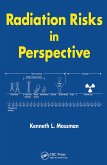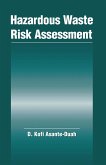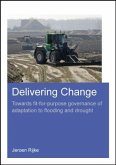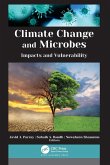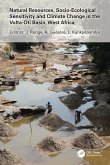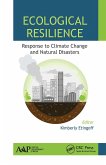Handbook of Irrigation Hydrology and Management
Irrigation Fundamentals
Herausgeber: Eslamian, Saeid; Eslamian, Faezeh
Handbook of Irrigation Hydrology and Management
Irrigation Fundamentals
Herausgeber: Eslamian, Saeid; Eslamian, Faezeh
- Broschiertes Buch
- Merkliste
- Auf die Merkliste
- Bewerten Bewerten
- Teilen
- Produkt teilen
- Produkterinnerung
- Produkterinnerung
The Handbook of Irrigation Hydrology and Management examines irrigated ecosystems in which water storage, applications, or drainage volumes are artificially controlled in the landscape and the spatial domain of processes varies from micrometers to tens of kilometers, while the temporal domain spans from seconds to centuries.
Andere Kunden interessierten sich auch für
![Ecotoxicology Ecotoxicology]() Colin WalkerEcotoxicology138,99 €
Colin WalkerEcotoxicology138,99 €![Radiation Risks in Perspective Radiation Risks in Perspective]() Kenneth L MossmanRadiation Risks in Perspective86,99 €
Kenneth L MossmanRadiation Risks in Perspective86,99 €![Hazardous Waste Risk Assessment Hazardous Waste Risk Assessment]() Kofi Asante-DuahHazardous Waste Risk Assessment92,99 €
Kofi Asante-DuahHazardous Waste Risk Assessment92,99 €![Delivering Change Delivering Change]() Jeroen RijkeDelivering Change80,99 €
Jeroen RijkeDelivering Change80,99 €![Climate Change and Microbes Climate Change and Microbes]() Climate Change and Microbes109,99 €
Climate Change and Microbes109,99 €![Natural Resources, Socio-Ecological Sensitivity and Climate Change in the Volta-Oti Basin, West Africa Natural Resources, Socio-Ecological Sensitivity and Climate Change in the Volta-Oti Basin, West Africa]() Natural Resources, Socio-Ecological Sensitivity and Climate Change in the Volta-Oti Basin, West Africa163,99 €
Natural Resources, Socio-Ecological Sensitivity and Climate Change in the Volta-Oti Basin, West Africa163,99 €![Ecological Resilience Ecological Resilience]() Ecological Resilience110,99 €
Ecological Resilience110,99 €-
-
-
The Handbook of Irrigation Hydrology and Management examines irrigated ecosystems in which water storage, applications, or drainage volumes are artificially controlled in the landscape and the spatial domain of processes varies from micrometers to tens of kilometers, while the temporal domain spans from seconds to centuries.
Hinweis: Dieser Artikel kann nur an eine deutsche Lieferadresse ausgeliefert werden.
Hinweis: Dieser Artikel kann nur an eine deutsche Lieferadresse ausgeliefert werden.
Produktdetails
- Produktdetails
- Verlag: CRC Press
- Seitenzahl: 406
- Erscheinungstermin: 29. November 2024
- Englisch
- Abmessung: 254mm x 178mm x 21mm
- Gewicht: 703g
- ISBN-13: 9781032457451
- ISBN-10: 1032457457
- Artikelnr.: 71909420
- Herstellerkennzeichnung
- Libri GmbH
- Europaallee 1
- 36244 Bad Hersfeld
- gpsr@libri.de
- Verlag: CRC Press
- Seitenzahl: 406
- Erscheinungstermin: 29. November 2024
- Englisch
- Abmessung: 254mm x 178mm x 21mm
- Gewicht: 703g
- ISBN-13: 9781032457451
- ISBN-10: 1032457457
- Artikelnr.: 71909420
- Herstellerkennzeichnung
- Libri GmbH
- Europaallee 1
- 36244 Bad Hersfeld
- gpsr@libri.de
Dr. Saeid Eslamian is professor of Hydrology at Isfahan University of Technology, where he heads the Hydrology Research Group in the Department of Water Engineering. His research focuses mainly on statistical and environmental hydrology and climate change. In particular, he is working on modeling and prediction of natural hazards including flood, drought, storms, wind, groundwater drawdown, and pollution for arid and semi-arid zones, particularly in urban areas. He is also a Visiting Professor at Princeton University, and University of ETH Zurich, Switzerland. He has contributed to more than 300 publications in books, research journals, and technical reports or papers in conferences. He is the Founder and Editor-in-Chief of both the International Journal of Hydrology Science and Technology and the Journal of Flood Engineering. He received ASCE and EWRI awards in 2009 and 2010 for his research. Dr. Faezeh Eslamian current research focuses on the fate and transport of phosphorus through subsurface drained farmlands. Dr. Eslamian completed her PhD at McGill University, and her bachelor's and master's degrees in civil and environmental engineering from Isfahan University of Technology, Iran, where she evaluated natural and low-cost absorbents for the removal of pollutants such as textile dyes and heavy metals. Furthermore, she has conducted research on the worldwide water quality standards, wastewater reuse, and drought guidelines.
Part I: Irrigation Hydrology. 1. Irrigation Hydrology: Landscape, Scales
and Social Context. 2. Infiltration and Irrigation Management. 3. Movement
of Water in Soil. Part II: Evapotranspiration and Water Requirements. 4. An
Introduction to Soil-Water-Plant Relationship. 5. Plant
Evapotranspiration-Concepts and Problems. 6. Plant Water Requirements and
Evapotranspiration. Part III: Environmental and Economical Impacts. 7.
Environmental Impacts of Irrigation. 8. Environmental Impact Assessment of
Irrigation. 9. Economic Viability of Irrigation Techniques. Part IV: Earth
and Satellite Measurements for Irrigation. 10. Irrigation Water
Measurement. 11. Irrigation and Agrometeorology: Innovative Remote Sensing
Applications in Crop Monitoring. Part V: Irrigation Water Quality Issues.
12. Irrigation with Reclaimed Municipal Wastewater: Opportunity or Risks.
13. Microbiology of Irrigation Water. 14. Phosphate and Nitrate Management
in Irrigation Water. 15. Use of Typha Latifolia as a Tool for Biomonitoring
of Domestic Effluents: Biochemical and Biomarkers Study. Part VI: Water
Harvesting for Irrigation. 16. Surface Runoff Water Harvesting for
Irrigation. 17. Water Harvesting for Rainfed Farming. 18. Optimization of
Reservoir Operation for Irrigation. 19. Reducing Nitrate Leaching and
Increasing Nitrogen Use Efficiency by Applying Nano-Fertilizers.
and Social Context. 2. Infiltration and Irrigation Management. 3. Movement
of Water in Soil. Part II: Evapotranspiration and Water Requirements. 4. An
Introduction to Soil-Water-Plant Relationship. 5. Plant
Evapotranspiration-Concepts and Problems. 6. Plant Water Requirements and
Evapotranspiration. Part III: Environmental and Economical Impacts. 7.
Environmental Impacts of Irrigation. 8. Environmental Impact Assessment of
Irrigation. 9. Economic Viability of Irrigation Techniques. Part IV: Earth
and Satellite Measurements for Irrigation. 10. Irrigation Water
Measurement. 11. Irrigation and Agrometeorology: Innovative Remote Sensing
Applications in Crop Monitoring. Part V: Irrigation Water Quality Issues.
12. Irrigation with Reclaimed Municipal Wastewater: Opportunity or Risks.
13. Microbiology of Irrigation Water. 14. Phosphate and Nitrate Management
in Irrigation Water. 15. Use of Typha Latifolia as a Tool for Biomonitoring
of Domestic Effluents: Biochemical and Biomarkers Study. Part VI: Water
Harvesting for Irrigation. 16. Surface Runoff Water Harvesting for
Irrigation. 17. Water Harvesting for Rainfed Farming. 18. Optimization of
Reservoir Operation for Irrigation. 19. Reducing Nitrate Leaching and
Increasing Nitrogen Use Efficiency by Applying Nano-Fertilizers.
Part I: Irrigation Hydrology. 1. Irrigation Hydrology: Landscape, Scales
and Social Context. 2. Infiltration and Irrigation Management. 3. Movement
of Water in Soil. Part II: Evapotranspiration and Water Requirements. 4. An
Introduction to Soil-Water-Plant Relationship. 5. Plant
Evapotranspiration-Concepts and Problems. 6. Plant Water Requirements and
Evapotranspiration. Part III: Environmental and Economical Impacts. 7.
Environmental Impacts of Irrigation. 8. Environmental Impact Assessment of
Irrigation. 9. Economic Viability of Irrigation Techniques. Part IV: Earth
and Satellite Measurements for Irrigation. 10. Irrigation Water
Measurement. 11. Irrigation and Agrometeorology: Innovative Remote Sensing
Applications in Crop Monitoring. Part V: Irrigation Water Quality Issues.
12. Irrigation with Reclaimed Municipal Wastewater: Opportunity or Risks.
13. Microbiology of Irrigation Water. 14. Phosphate and Nitrate Management
in Irrigation Water. 15. Use of Typha Latifolia as a Tool for Biomonitoring
of Domestic Effluents: Biochemical and Biomarkers Study. Part VI: Water
Harvesting for Irrigation. 16. Surface Runoff Water Harvesting for
Irrigation. 17. Water Harvesting for Rainfed Farming. 18. Optimization of
Reservoir Operation for Irrigation. 19. Reducing Nitrate Leaching and
Increasing Nitrogen Use Efficiency by Applying Nano-Fertilizers.
and Social Context. 2. Infiltration and Irrigation Management. 3. Movement
of Water in Soil. Part II: Evapotranspiration and Water Requirements. 4. An
Introduction to Soil-Water-Plant Relationship. 5. Plant
Evapotranspiration-Concepts and Problems. 6. Plant Water Requirements and
Evapotranspiration. Part III: Environmental and Economical Impacts. 7.
Environmental Impacts of Irrigation. 8. Environmental Impact Assessment of
Irrigation. 9. Economic Viability of Irrigation Techniques. Part IV: Earth
and Satellite Measurements for Irrigation. 10. Irrigation Water
Measurement. 11. Irrigation and Agrometeorology: Innovative Remote Sensing
Applications in Crop Monitoring. Part V: Irrigation Water Quality Issues.
12. Irrigation with Reclaimed Municipal Wastewater: Opportunity or Risks.
13. Microbiology of Irrigation Water. 14. Phosphate and Nitrate Management
in Irrigation Water. 15. Use of Typha Latifolia as a Tool for Biomonitoring
of Domestic Effluents: Biochemical and Biomarkers Study. Part VI: Water
Harvesting for Irrigation. 16. Surface Runoff Water Harvesting for
Irrigation. 17. Water Harvesting for Rainfed Farming. 18. Optimization of
Reservoir Operation for Irrigation. 19. Reducing Nitrate Leaching and
Increasing Nitrogen Use Efficiency by Applying Nano-Fertilizers.



